Leon Wang designs posters with impact
It was the Philando Castile shooting in July 2016 that ultimately drove Leon Wang to action.
“It happened in my community, on the streets I drive on, in the area my kids are growing up in,” Wang says. “I knew I needed to do more. I thought, ‘There has to be more I can do to help’ and ‘What can I do?’ The best I had to offer was my design skills.”
The day after the shooting, Wang designed an 11”x17” poster. Made to look like the Minnesota state license plate, the letters spelled out “SHAME.”
“It was a visceral reaction and a cathartic piece for myself,” he explains.
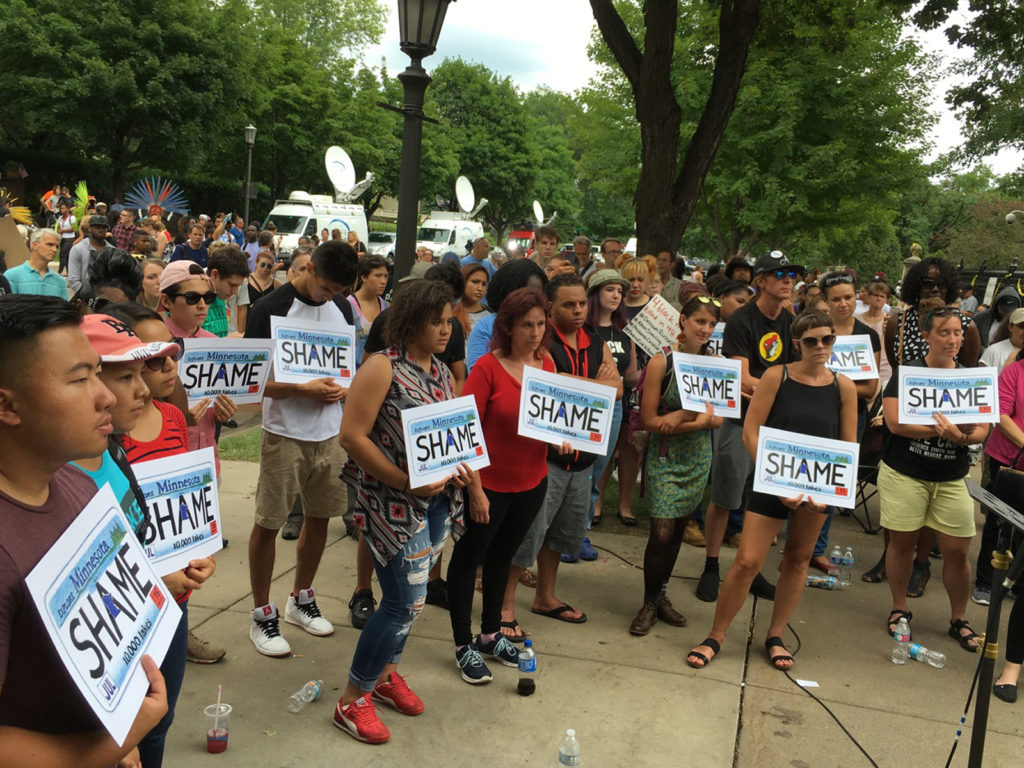
He took his poster and went down to the Governor’s Residence where people had been gathering in protest and solidarity and found that the poster seemed to resonate with others. So he left, went back home, printed out 30 more copies of the “Shame” poster, came back and passed them out to the crowd.
“It seemed to me that these small posters made a visual impact in a good sized crowd out in the street,” he reflects. “That was the beginning of this journey, really. This first poster helped me realize that one person with just simple resources can make an impact. I’m drawing this at home on my computer, putting it on a USB stick, riding my bike down the street to the UPS store, printing them out and delivering posters hot off the press to people on the street.”
After the initial visceral reaction of that first poster, Wang took a step back and studied the reaction to that poster, then tried to replicate that impact and improve upon it. In the last year he has designed over 50 posters for different social justice events and movements. Each poster is designed as a tool to support the front line people demonstrating out in the streets with a specific message. The posters are meant to help amplify the voice of people out in the street – rather than a static piece of art hanging on a wall.
With any poster he designs, it starts with him seeing things that are happening in the world and feeling a call to action.
“I believe everything starts with the individual voice, if you can connect with your own humanity, everything else will follow.” he says. Movements like Standing Rock and Black Lives Matter inspire him to get involved and ask what he can do to help. “When I see these issues, my first question is, how are we connected in all of this. Under all the layers of stuff we carry around, there is our unique voice and a common humanity.”
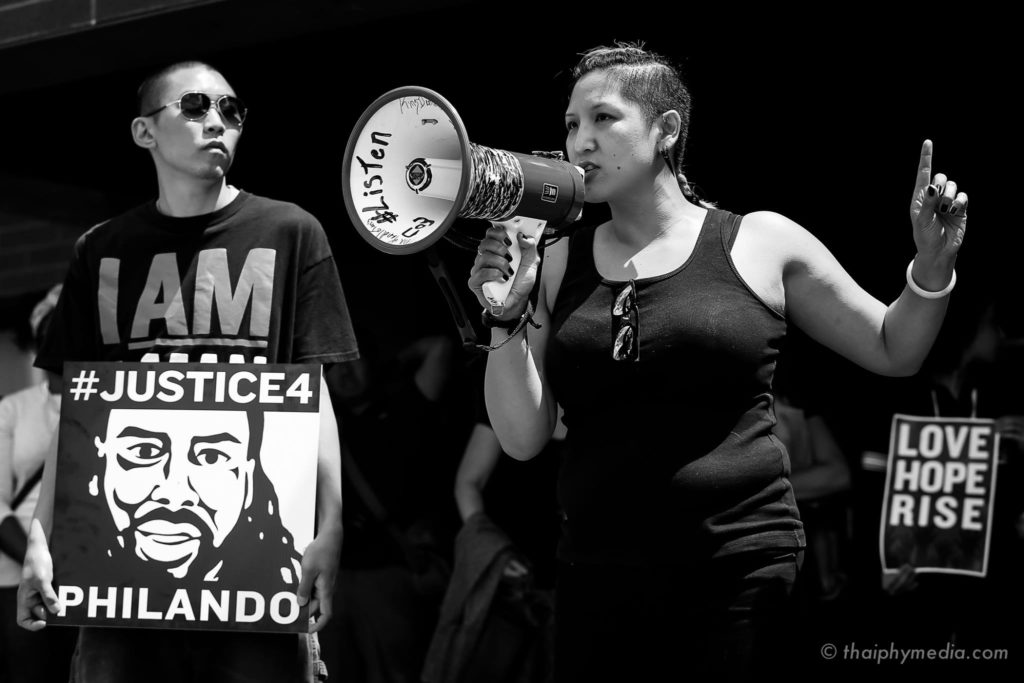
Wang has worked closely with many activist groups. His artwork is a synthesis of his voice and the goals and narratives established by the organizers. Leon does all the design, production and distribution work.
He has designed visual pieces for both small and large activist groups, including the clergy and veteran solidarity actions at Standing Rock, Black Lives Matters movement in the Twin Cities. Some actions he participated in may only have a turnout of a few dozen, while others such as March for Science saw about 40,000 people in at the Minnesota State Capitol.
Besides coordinating with organizers on messaging, he also works with the family of victims to ensure that their wishes are respected. “If there is a victim and family involved, I always check in with the family to make sure they’re okay with everything we do,” he says.
“This is my personal journey and is one way I am able to help my community,” he says. “Myself and everyone in the movement, we’re all working with limited resources and limited capacity. For me, with this poster project, I try to take a look at what we have to work with [given limited money and limited time]. What can I do to make the greatest impact given the resources I have?”
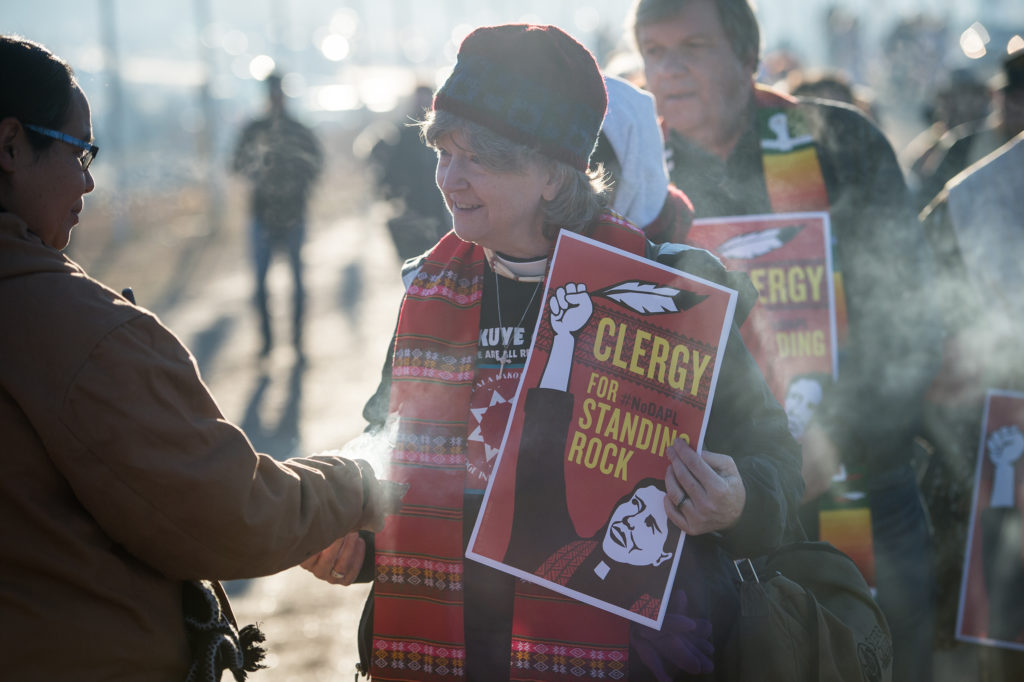
While Wang began this poster work a little over a year ago, with everything that has happened since the current administration took office in January it has felt like a lifetime ago. Still, Wang says, in some communities it’s a whole lot of nothing new, and he cautions against being too reactionary.
“[Issues like] white supremacy and oppression were happening all along, but they’re now coming to the forefront because they are being further encouraged and institutionalized,” he says. “That’s put more pressure and more trauma on our community and demands an even stronger reaction, but at the same time all of this has been happening before and in some communities for hundreds of years, so in a sense it’s nothing new. There are many horrific things that are happening with the current administration, but my approach is to not let them define us. A lot of what is being done and said is at a pretty low level, and you really don’t want to be reacting or engaging at that level. You want to take the high road, but you also want to understand what you’re grounded in.
“One huge lesson from Standing Rock is that before there can be any talk of tactics or ideology, it is important to know what you are grounded in, When you first step into camp, you are first greeted with ‘This is who we are as a people; this is what we’re grounded in. We are a peaceful and prayerful.’ As a movement it’s important to know what we’re grounded in, both as individuals and as a group. If you don’t first consider how your are grounded, the battle will be that much more difficult.”
The day after the election, he anticipated there would be massive expressions of rage out in the streets with language like “F*** Trump,” “Not My President”. But as a way to help define the fight on our terms, he created a simple poster with the words “Love Hope Rise”.
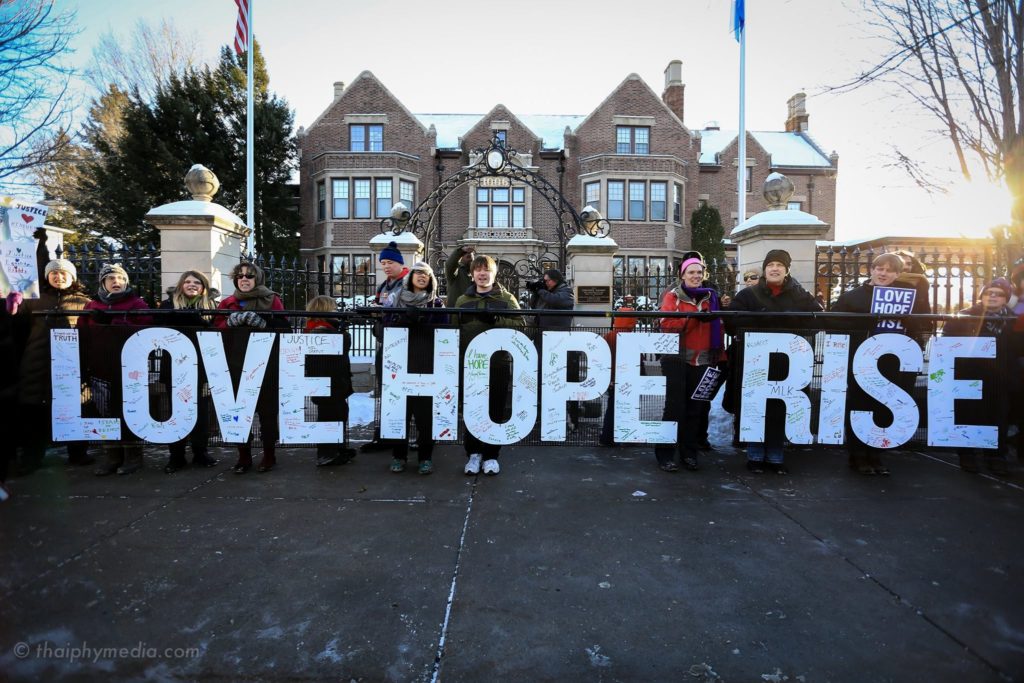
“That was a reminder for myself that it’s fine to go through this period of anger and disappointment, but in the end you have to come back what grounds you, what sustains you, what helps you move forward,” he says. Love Hope Rise became a personal mantra for my activism work. That poster also resonated with people more than any other designs I’ve done.”
Leon Wang grew up in authoritarian Taiwan. His family was heavily involved in the opposition movement, He lived through an era of martial law and police state, but ultimately saw Taiwan transform into a leading democratic state in Asia. This perspective instilled a sense of hope that help shaped his outlook for the rest of his life.
Wang’s family emigrated from Taiwan at age 11 and settled in Minneapolis. Though he studied and worked in architecture for many years, social justice issues continued to be a concern throughout his adult life, and he would help out and contribute wherever he could.
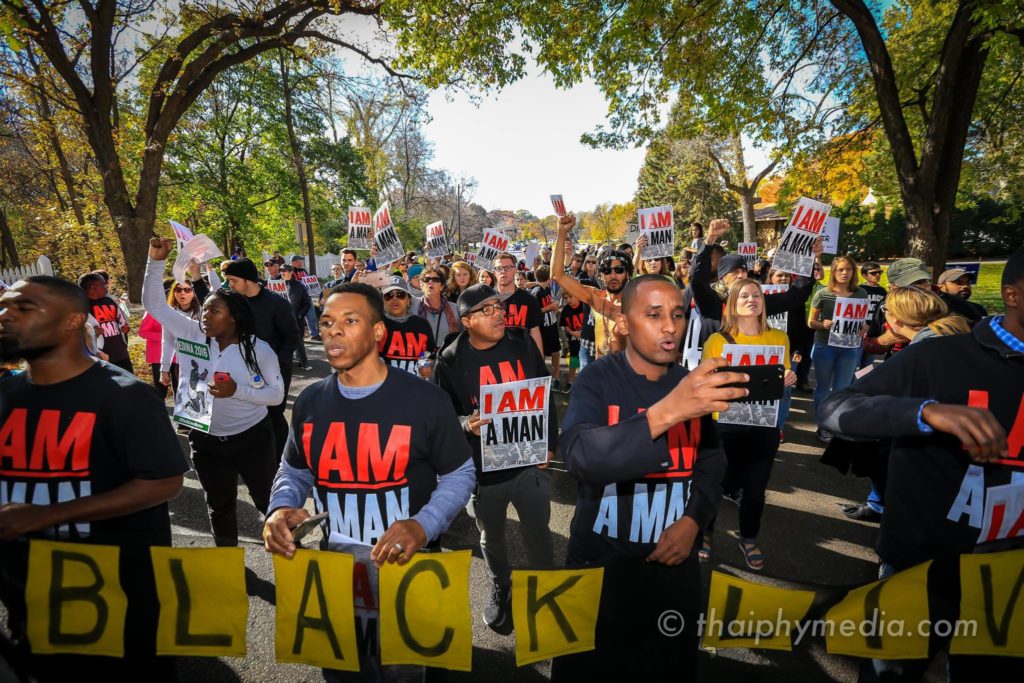
He eventually transitioned his professional work from architecture to toy design to launching his own design education company, Firebird Design Lab, marrying his passion for using design to “make sense of the world” with his desire to educate.
“At one point I had to decide if I wanted to be an architect or a teacher. I’m an educator at heart, but I thought I might be easier to start in architecture and go towards teaching. The teaching part is more fulfilling than just strictly design.”
Through Firebird Design Lab, Wang visits school classrooms with an intensive design studio program, teaching students holistic problem solving skills using design as a tool.
“There is a little bit of art and a little bit of science,” he says. “But I am really teaching the kids to ask the right questions, then we work through a process for them to figure out the best solution using the resources at hand.”
This is the exact same approach he uses in activist artwork – what he calls “purposeful creativity.”
For Wang, his activist work creating posters dovetails with his educational work teaching students, and he has started offering workshops for adults on topics like, for one, designing social justice posters.
“I’m sharing my process with people about how you can take the issues on your hearts and mind and distill them to a simple, clear message that can connect with people on multiple levels,” he says. “This is my own journey and process, the idea of being really intentional and purposeful about the work I do, and I’m trying to share that process with other people. It’s sort of my two worlds converging.”

(1) How do you like to collaborate?
I think everything starts with the inner voice and our humanity on one end, and on the other end, the desire to impact our environment. Whatever needs to happen in between, I’m open to. It may sometimes mean following a lone vision, and other times it’s collaborating with or deferring to others – I’ll do whatever is necessary for a given situation.
(2) How do you a start a project?
Sometimes an incident happens out in the community, or it can be a simmering issue that rears up and demands a response. Then I start thinking, conceptualizing, and engaging people on “How do we move forward and address this through action and art?”
(3) How do you talk about your value?
A lot of that comes from the community. It’s not for me to answer how much value I’m providing. I am just doing my part to help, trying to get in touch with my humanity and the humanity of others. My goal is to make meaningful connections with simple pieces of art; it’s up to the community to decide how valuable my work is.
(4) How do you define success?
If we are able to make an impact within our community, and also extend outside the movement with clear and unifying message, that’s one thing that all the efforts feel worthwhile. Another thing, in terms of my artwork, the most satisfying comment I can get is someone saying, “I saw this poster and it inspired me to go home and make my own poster, or write poetry, or create something of my own.”
(5) How do you fund your work?
Early on in the poster project, I had to demonstrate that this was a valid approach; I donated the vast majority of the printing cost out of my own pocket. I think folks are beginning to appreciate the utility the posters, so I am able to recover a bit more of the costs. I’m working on building a sustainable model to provide stable, long term funding for the project. It’ll probably a bit of a “Robin Hood” approach. I think that is fitting for this type of work.

they got to keep it real
Would you be interested in visiting my school in St. Paul? I’m looking for examples and resources for my art program on making impactful posters…
You’ll want to contact Leon directly, you can do that via Firebird Design Lab – http://www.firebirddesignlab.com/new-page/